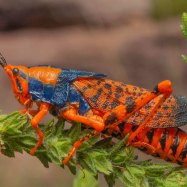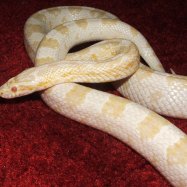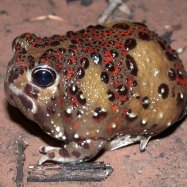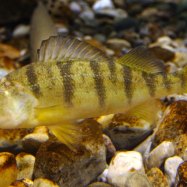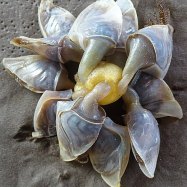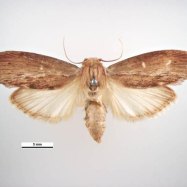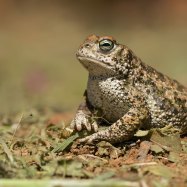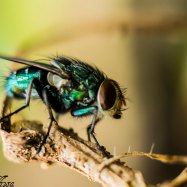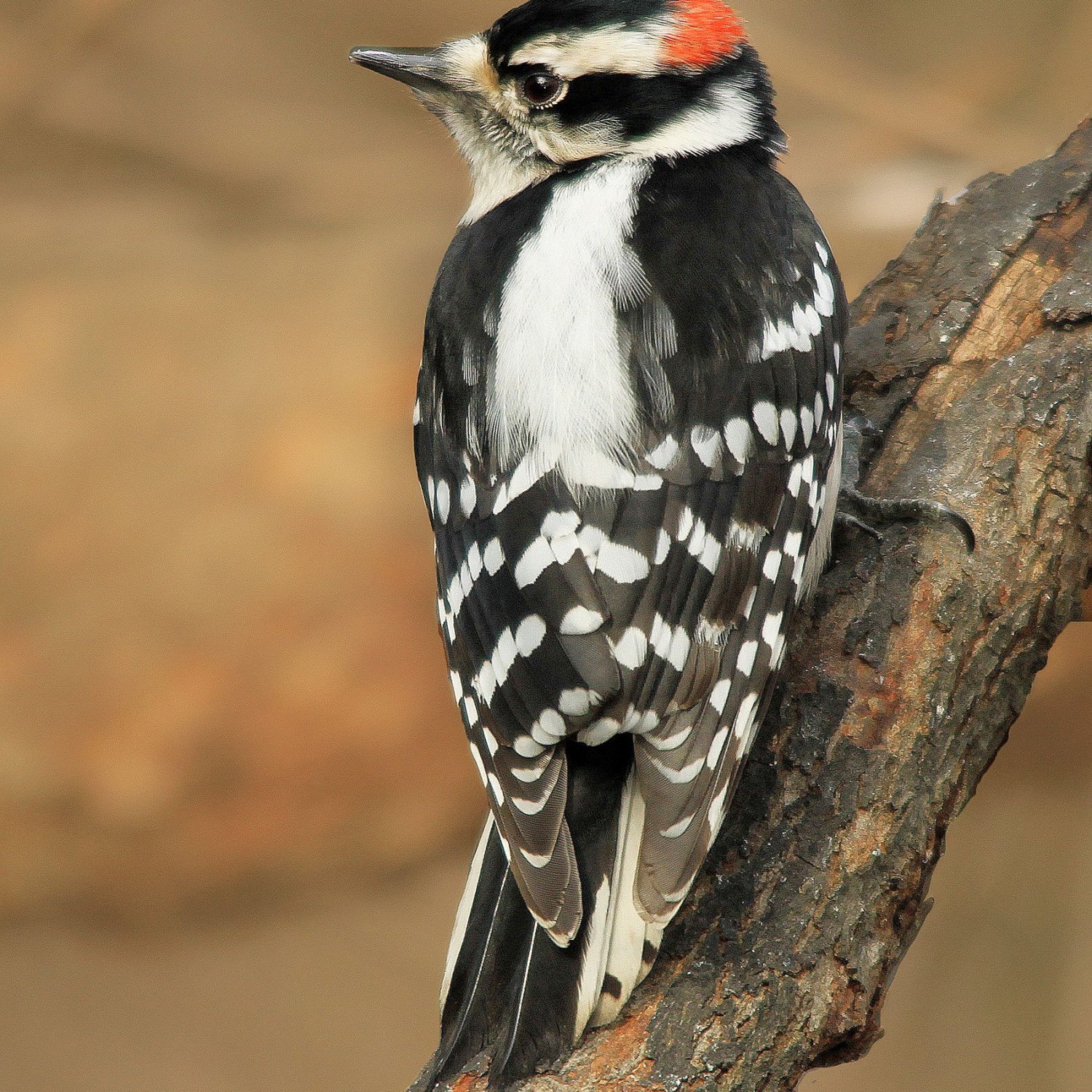
Downy Woodpecker
14-17 cm (5.5-6.7 in)
Meet the downy woodpecker, a small and compact bird found in the eastern US and southern Canada. This adorable creature measures 14-17 cm and belongs to the Picidae family. With its striking black and white feathers and expert tree-climbing skills, the downy woodpecker is a true wonder of nature. Keep an eye out for this lively bird on your next outdoor adventure!
Animal Details Summary:
Common Name: Downy Woodpecker
Kingdom: Animalia
Habitat: Forests, woodlands, parks, and gardens
The Endearing Downy Woodpecker: A Fascinating Forest Companion
Amidst the vast expanse of North American forests, one can hear the unmistakable sound of a small, yet powerful drumming echoing through the trees. It is the signature sound of the downy woodpecker, a charming and captivating bird that has captured the hearts of many nature enthusiasts. With its striking black and white coloration and agile movements, the downy woodpecker is a familiar sight in forests, woodlands, parks, and even gardens. In this article, we will delve deeper into the life of this enchanting bird, exploring its habitat, feeding habits, and unique adaptations that make it an essential part of the ecosystem Downy Woodpecker.The Scientific Name and Classification of the Downy Woodpecker
The downy woodpecker belongs to the scientific genus Picoides of the Picidae family. Its scientific name is Picoides pubescens, with "pubescens" referring to its downy soft plumage. Despite its scientific name, it shares its genus with several other woodpecker species, including the hairy woodpecker, Nuttall's woodpecker, and Ladder-backed woodpecker. However, the downy woodpecker is the most widespread and well-known of these species.Physical Characteristics and Geographical Distribution
The downy woodpecker is a small-sized bird, with a compact body and an average length of 14-17 cm (5.5-6.7 in). It is among the smallest woodpecker species in North America, with a weight ranging from 28-33 grams. Its body shape is cylindrical, with short legs and a long, chisel-like bill used for excavating insects from trees Deer Tick.One of the most distinctive features of the downy woodpecker is its black and white coloration. Its head, wings, and back are covered in black feathers, while its belly and underparts are adorned with white feathers. The feathers on its mantle and back are finely dotted with white, giving it a speckled appearance. The male downy woodpecker has a small red patch on the back of its head, while the female has a white patch instead.
The downy woodpecker can be found throughout North America, including the United States and southern Canada. It prefers to live in eastern parts of the United States, where it can be found year-round. However, during the winter months, some individuals may migrate to the southern states for better foraging opportunities.
The Habitat of the Downy Woodpecker
The downy woodpecker is a versatile bird, capable of thriving in various habitats. However, it is most commonly found in deciduous and mixed forests, where it can forage and nest in trees. It is also frequently spotted in woodlands, parks, and gardens, making it a familiar sight to many people.One of the primary requirements of the downy woodpecker's habitat is the presence of suitable trees for foraging and nesting. It prefers to live in areas with a mix of tall trees and shrubs, providing it with a diverse food source and shelter. The downy woodpecker is well-adapted to living in human-altered habitats, and it is not uncommon to see it in suburban areas, especially if there are trees and bird feeders present.
Feeding Habits and Adaptations
As an insectivorous bird, the downy woodpecker's diet primarily consists of insects and larvae found inside trees. It uses its powerful beak to excavate holes and crevices in the bark, providing access to its prey. It has a long tongue, with barbed tips, which it uses to impale and extract insects from their hiding places.Aside from insects, the downy woodpecker also consumes fruits and seeds, especially during the winter months when insect activity is limited. It is also an opportunistic feeder and will readily visit bird feeders, where it feeds on suet, seeds, and other food offerings.
The downy woodpecker's bill and tongue are uniquely adapted to its feeding habits. Its sturdy bill can withstand the repetitive pecking and digging into trees, while its flexible and barbed tongue is essential for capturing and extracting insects.
Behavior and Life Cycle
The downy woodpecker is a solitary bird, and while it may forage in small groups during the winter, it generally prefers to live and feed alone. It is a diurnal bird, meaning it is most active during daylight hours, with early morning being its peak feeding time.The breeding season for the downy woodpecker starts in early spring, and it is monogamous, forming lifelong pair bonds. The male downy woodpecker attracts a female by drumming on trees, producing a loud and distinctive sound. Once a pair has formed, they work together to excavate a nesting cavity in a tree, which they line with soft materials such as wood chips and feathers.
The female downy woodpecker lays an average of 4-5 eggs, which both parents take turns incubating for 12-14 days. After the eggs hatch, both the male and female take turns feeding and caring for the chicks. The young birds fledge after 20-25 days and continue to receive parental care for a few more weeks before becoming independent.
The Importance of the Downy Woodpecker in the Ecosystem
The downy woodpecker plays a vital role in the ecosystem, primarily through its feeding habits. By consuming insects, it helps control their populations, which, in turn, helps maintain overall forest health. It also serves as an indicator species, meaning that its presence or absence can indicate the health of the forest.Furthermore, the downy woodpecker is also an essential seed disperser, helping to propagate plant species in different areas. By storing and caching seeds in tree cavities, it contributes to the creation of new trees and maintains the species diversity in the forest.
The Future of the Downy Woodpecker
Despite being one of the most widespread woodpecker species in North America, the downy woodpecker faces some threats to its survival. Habitat loss and fragmentation, primarily due to deforestation, have led to a decline in its population in some areas. The use of pesticides and insecticides in agriculture also poses a threat to its food sources and indirectly affects its survival.Conservation efforts, such as preserving and restoring forest habitats, can help mitigate these threats and ensure the survival of the downy woodpecker. Individuals can also contribute to the conservation of this species by providing suitable nesting sites and avoiding the use of harmful chemicals in their surroundings.
Conclusion
In conclusion, the downy woodpecker is a charming and captivating bird found in the forests of North America. With its striking black and white coloration, powerful beak, and specialized tongue, it has adapted well to its habitat and feeding habits. It plays a significant role in the ecosystem, contributing to the health and diversity of forest ecosystems. However, it also faces threats, and it is crucial to continue conservation efforts to ensure its survival for future generations to appreciate and admire. So the next time you hear the rhythmic drumming of a downy woodpecker, take a moment to appreciate the beauty and importance of this humble, yet fascinating, woodland companion.

Downy Woodpecker
Animal Details Downy Woodpecker - Scientific Name: Picoides pubescens
- Category: Animals D
- Scientific Name: Picoides pubescens
- Common Name: Downy Woodpecker
- Kingdom: Animalia
- Phylum: Chordata
- Class: Aves
- Order: Piciformes
- Family: Picidae
- Habitat: Forests, woodlands, parks, and gardens
- Feeding Method: Insectivorous
- Geographical Distribution: North America
- Country of Origin: United States
- Location: Eastern United States and southern Canada
- Animal Coloration: Black and white
- Body Shape: Small, compact
- Length: 14-17 cm (5.5-6.7 in)
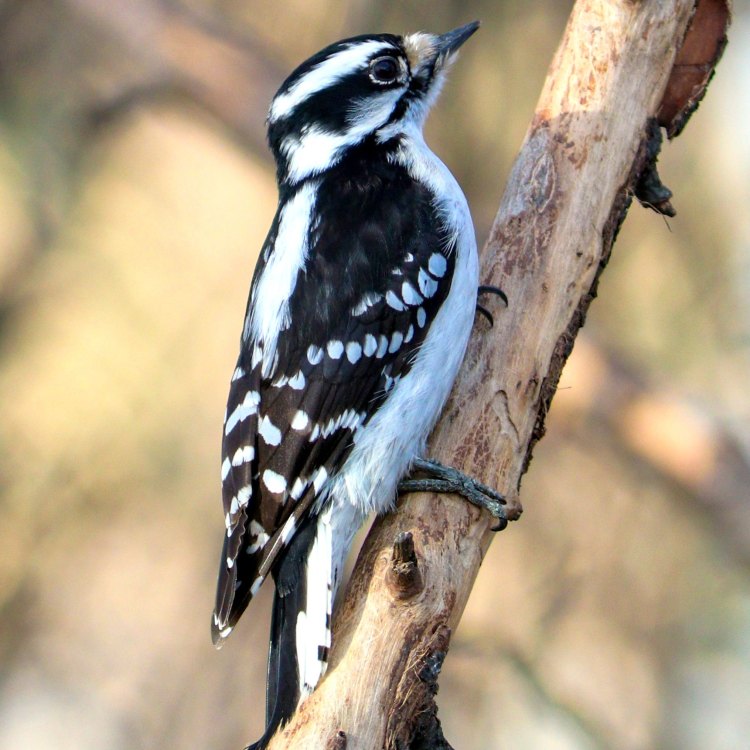
Downy Woodpecker
- Adult Size: Small
- Average Lifespan: 5-12 years
- Reproduction: Monogamous
- Reproductive Behavior: Cavity nesters
- Sound or Call: Distinct drumming sound and a high-pitched whinny
- Migration Pattern: Some individuals migrate, while others are non-migratory
- Social Groups: Solitary or in pairs
- Behavior: Climbing trees and probing bark for insects
- Threats: Habitat loss, predation, and collisions with human-made structures
- Conservation Status: Least Concern
- Impact on Ecosystem: Helps control insect populations
- Human Use: Birdwatching
- Distinctive Features: Black wings with white spots, black-and-white striped head with a small red patch on the nape
- Interesting Facts: The Downy Woodpecker is the smallest and most common woodpecker in North America.
- Predator: Birds of prey and domestic cats
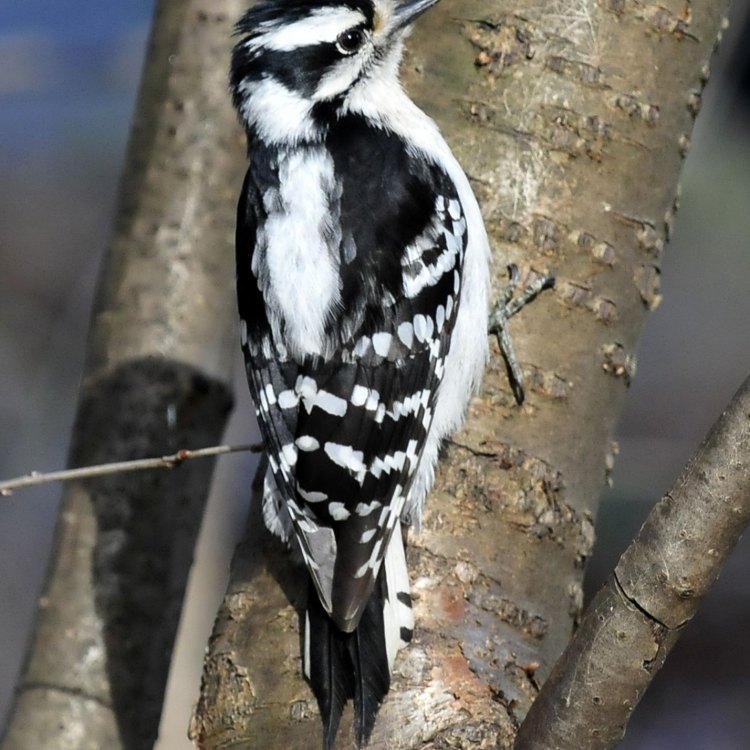
Picoides pubescens
The Downy Woodpecker: Small in Size, Big on Impact
When we think of woodpeckers, we often picture the iconic Pileated Woodpecker with its large size and bright red crest. But there is another, smaller woodpecker that is just as fascinating and influential in its environment: the Downy Woodpecker.The Downy Woodpecker (Picoides pubescens) is a small, but mighty bird that is found throughout North America. In this article, we will dive into the unique features and behaviors of this bird, its impact on the ecosystem, and the human fascination with this charismatic species PeaceOfAnimals.Com.
Size and Lifespan
As mentioned, the Downy Woodpecker is a small bird, measuring only 6-7 inches (15-18 cm) in length and weighing just 0.8-1 oz (23-28 g). This makes it the smallest woodpecker in North America, even smaller than its close relative, the Hairy Woodpecker.
Despite its small size, the Downy Woodpecker has an impressive average lifespan of 5-12 years. This is largely due to its adaptability and resourcefulness in finding food and avoiding predators.
Reproduction and Social Behavior
Downy Woodpeckers are monogamous birds, forming pairs that last throughout the breeding season. During this time, they engage in courtship displays, with the male pecking at various objects to create a drumming sound that can be heard from distances as far as one mile away. The male also does a high-pitched whinny as part of the courtship display.
One unique aspect of the Downy Woodpecker's reproductive behavior is its use of cavities for nesting Deutsche Bracke. They typically lay 4-5 eggs in a nest that they excavate in dead or decaying trees, using their sharp beaks to create the perfect-sized hole. This behavior has become crucial for their survival, as it provides a safe and protected space for their young.
Migratory Patterns
The Downy Woodpecker exhibits a varied migration pattern. Some individuals migrate to warmer climates during the winter, while others remain in their breeding range all year round. This is likely due to the availability of food and shelter in different regions.
The non-migratory behavior of some Downy Woodpeckers has actually led to the formation of distinct subspecies, such as the Florida Downy Woodpecker and the Cuban Downy Woodpecker, which are found in their respective regions year-round.
Behavior and Adaptations
When it comes to food, Downy Woodpeckers are not picky. They have a varied diet, consisting mostly of insects, but also including fruits, seeds, and tree sap. To obtain their food, they use their strong, pointed beaks to probe bark and deep crevices in trees. They also have a specialized tongue that is coated with barbs and sticky saliva, making it easier for them to reach and catch insects.
Their strong beaks also come in handy when it comes to their unique climbing behavior. Downy Woodpeckers can scale trees and vertical surfaces with ease, using their sharp claws to grip onto the bark while they use their beaks to drill into it.
What is even more impressive is their ability to navigate and move around in different orientations, such as head-down or sideways, without experiencing any negative effects. This is due to their specialized neck muscles and skull structure, which minimize the impact of repeated head-banging movements while foraging for food.
Threats and Conservation Status
Like many other species, the Downy Woodpecker faces threats to its survival, with the main ones being habitat loss, predation, and collisions with human-made structures. As humans continue to clear forests and expand their urban areas, the Downy Woodpecker loses its natural habitat and nesting sites. This can have a significant negative impact on their breeding success and overall population.
Additionally, predators such as birds of prey and domestic cats pose a threat to Downy Woodpeckers, as they are small and vulnerable to attacks. To combat these threats, the conservation status of the Downy Woodpecker is listed as Least Concern, with ongoing efforts to protect and preserve their habitats.
Impact on the Ecosystem
Despite their small size, Downy Woodpeckers play a vital role in their ecosystem. As cavity nesters, they create holes in trees that provide shelter and nesting sites for other bird species, such as chickadees, nuthatches, and wrens. They also help control insect populations, making them an essential part of the food web.
Their pecking and foraging behavior also contribute to the decomposition of dead or decaying trees, which is essential for nutrient cycling and soil health. This makes them ecosystem engineers, playing a crucial role in maintaining the balance and health of their environment.
Human Usage and Fascination
One of the most popular human uses of Downy Woodpeckers is birdwatching. Their striking black-and-white coloration, with black wings and a white-spotted back, and their black-and-white striped head with a small red patch on the nape, makes them easy to spot and identify. Many birders also enjoy listening to their distinctive drumming sound, which is considered a win-win for both birds and humans.
Aside from birdwatching, the Downy Woodpecker is also a popular species for study and research. Their unique behaviors, such as their climbing abilities and foraging techniques, have inspired scientists to delve deeper into understanding the biomechanics behind their survival strategies.
Interesting Facts
To wrap up, here are a few more interesting facts about the Downy Woodpecker:
- They are excellent hitchhikers, often hiding in trucks, cars, or even on clotheslines to get to new areas.
- They have a special way of communicating with each other, using drumming patterns to indicate danger, territorial boundaries, or food sources.
- They are hardly ever seen at bird feeders, preferring to search for food in trees.
- They are known to roost in tree cavities in groups during the winter to conserve warmth.
In Conclusion
The Downy Woodpecker may be small in size, but its impact on the ecosystem and human fascination is anything but insignificant. Their unique behaviors, adaptability, and conservation status make them a vital and intriguing species to study and protect. So, the next time you come across a Downy Woodpecker, take a moment to appreciate its beauty and all that it contributes to the world around us.
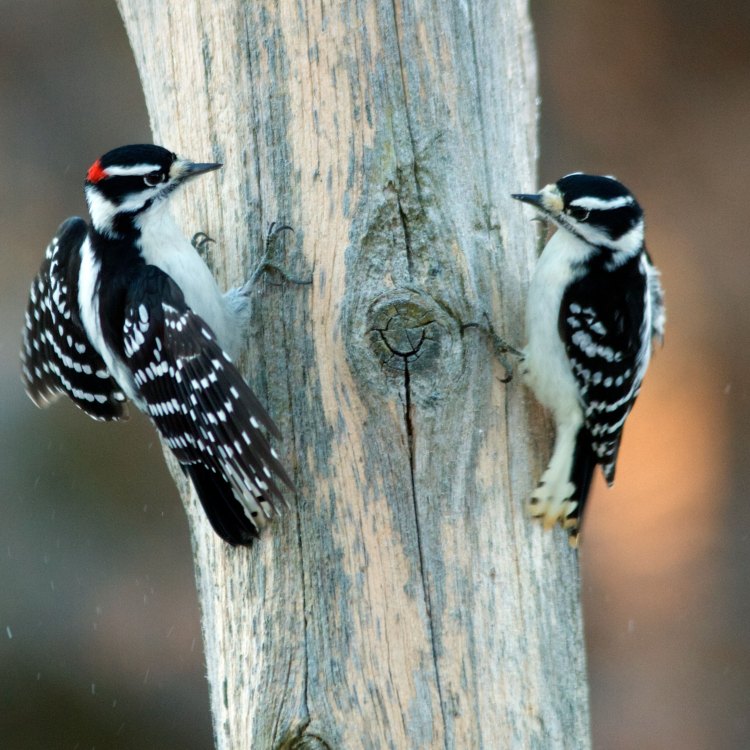
The Endearing Downy Woodpecker: A Fascinating Forest Companion
Disclaimer: The content provided is for informational purposes only. We cannot guarantee the accuracy of the information on this page 100%. All information provided here may change without prior notice.


